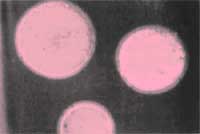Crystal clear
 sensors could soon become more accurate and economical with the help of a new material. These sensors could be used in a variety of applications such as to determine the levels of various compounds like glucose in the blood or the levels of toxic elements in drinking water. John Holz and Sanford Asher at the University of Pennsylvania, Pittsburgh, usa , have developed a crystalline colloidal array of polymer spheres. To form a colloidal crystal, they have filled the space between tiny plastic spheres with a chemically functionalised gel (Nature , Vol 389, No 6653).
sensors could soon become more accurate and economical with the help of a new material. These sensors could be used in a variety of applications such as to determine the levels of various compounds like glucose in the blood or the levels of toxic elements in drinking water. John Holz and Sanford Asher at the University of Pennsylvania, Pittsburgh, usa , have developed a crystalline colloidal array of polymer spheres. To form a colloidal crystal, they have filled the space between tiny plastic spheres with a chemically functionalised gel (Nature , Vol 389, No 6653).
The gel is a network of crosslinked polymer strands saturated like a sponge with a fluid solvent. A small change in the composition of the fluid can lead to a phenomenal increase in the volume of the gel. Chemically functionalised gels can be tailor-made in such a way that they respond to a specific stimulus such as the concentration of a particular ion in solution.
Till today, there has been a limited use of the gels as sensors. The reason is that there has not been an accurate method to calibrate the swelling of the gel in response to the specific chemical. However, by incorporating the colloidal crystals in the gel, Holz and Asher have now formed a composite material that can respond to small changes in a chemical composition. Colloidal crystals are regular arrays of small particles (in this case about 100 nanometres in diameter) suspended in a fluid.
The researchers have devised a method so that hydrogel swells in the presence of glucose and certain metal ions. The crystalline colloid has specific optical properties, in particular diffraction properties. It means that the spacing between the molecules bends light by a definite proportion that can be measured by appropriate instruments.
When the gel swells in presence of the target chemical such as glucose, the mean distance between the molecules increases, leading to a change in the diffraction caused by it. This gives an unambiguous signal for the chemical. Further, the change in its optical properties is also visible because the colour changes in presence of ions such as lead. In the present case, the colour changes to blue for a lower concentration and green for a higher concentration. The researchers are optimistic about the use of such materials in cheap and accurate sensors. The sensors would help ful in clinical and environmental diagnostics
Related Content
- Africa Must Act Against the Ballooning Indian Ocean Plastic Patch
- Tracking progress of the 2020 climate turning point
- In the Seychelles, coral reefs face climate change threat
- Coral bleaching spreads to Maldives, devastating spectacular reefs
- Study finds slim odds of record heat, but not as slim as reported
- Australia keeps fingers crossed UNESCO won't blacklist Great Barrier Reef
